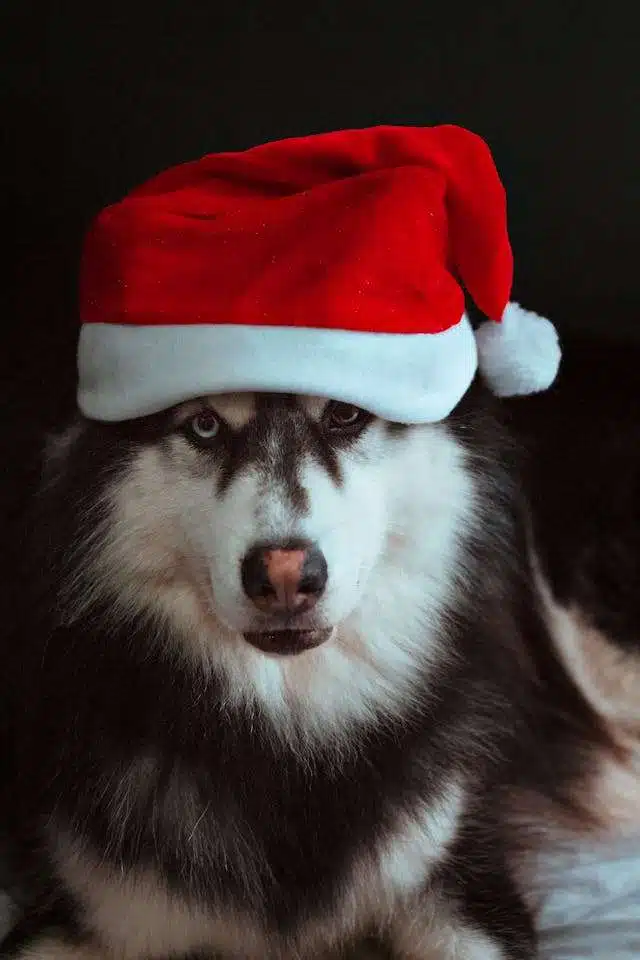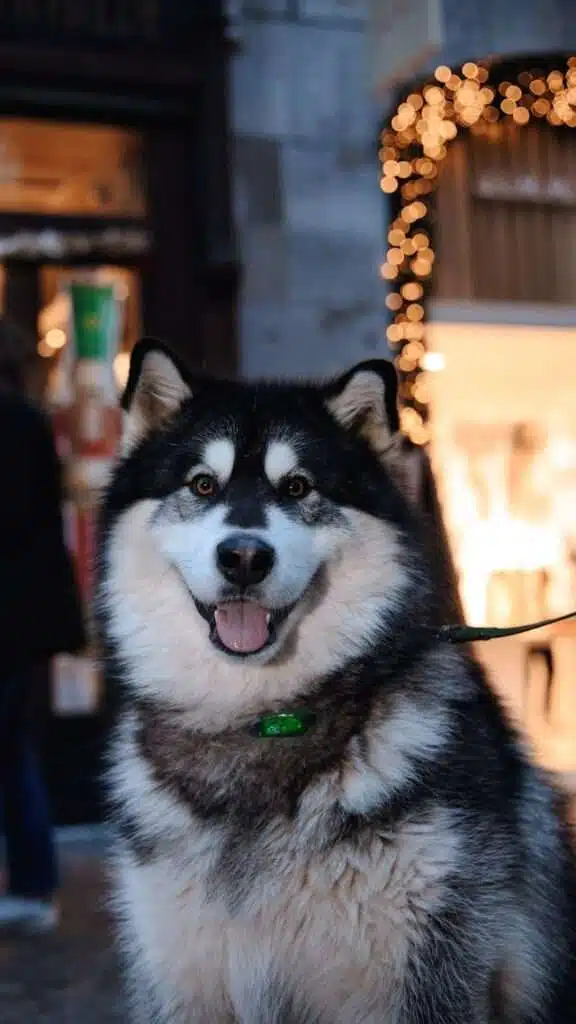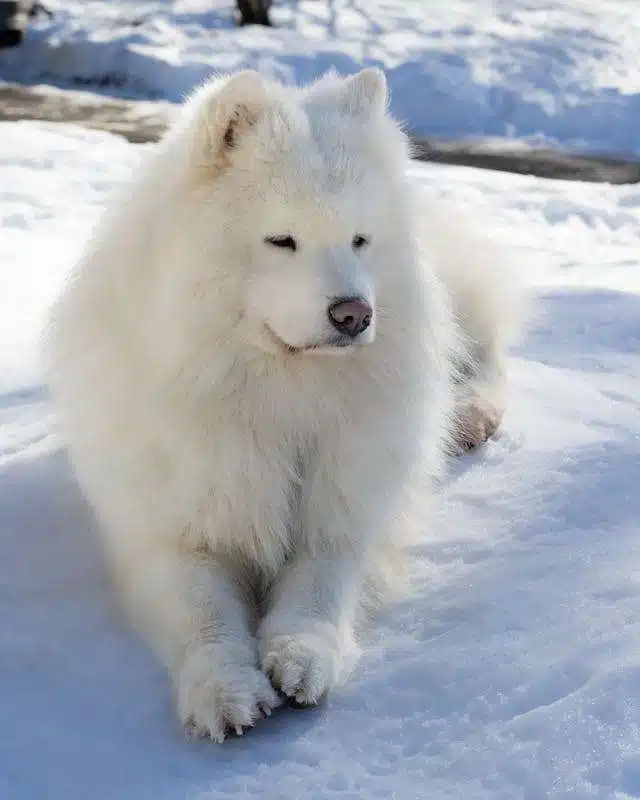Husky breeds are known for their striking appearanace, friendly demeanor, and impressive endurance. Potential owners need to understand the different types of husky breeds before getting one. In this comprehensive guide, we will delve into the fascinating world of husky breeds and explore 7 distinct types that you should know about.
Table of Contents
ToggleThe 7 Types Of Husky Breeds
1. Alaskan Husky

In the world of sled dogs, the Alaskan Husky reigns supreme. In the types of husky breeds Alaskan Husky is on the top. Unlike its more recognized counterparts—the Siberian Husky and the Alaskan Malamute—the Alaskan Husky is not a breed in the traditional sense but a category of dog optimized for the rigorous demands of sled pulling.
Key Charecteristic:
Physically, the Alaskan Husky is a blend of its ancestors, with a lean, muscular build and a double coat to withstand cold climates. Their appearance varies widely, focusing on ability rather than aesthetics. Weighing in at 40 to 60 pounds, these dogs are known for their intelligence, endurance, and friendly disposition.
Roles and Responsibilities:
Alaskan Huskies excel in sled dog racing, dominating events like the Iditarod with their speed and stamina. Beyond the race circuit, they serve as working dogs in remote areas, offering transportation and companionship. They are well-suited for active families or individuals who can provide ample outdoor exercise.
Care and Health:
These dogs require regular exercise and grooming, especially during shedding season. They are generally healthy, thanks to their diverse genetic background, but can be prone to conditions like hip dysplasia and eye problems. Regular veterinary care is essential to keep them in top shape.
2. Alaskan Malamute

Among the larger types of Husky breeds, the Alaskan Malamute is a strong, heavy-duty working dog best suited for cold climates. The Malamute is smart and thrives in a pack setting. Dogs of this breed were developed for their strength and endurance as sled dogs to pull heavy freight over long distances in heavy snow. Currently, they’re mostly companion dogs. However, it requires lots of exercise. Owning a malamute dog breed has advantages and challenges.
Alaskan Malamutes are active dogs with high endurance and require energetic owners who can take these large dogs for long walks and other activities during the day. Malamutes have a double coat that keeps them warm in cold climates. As a result, malamutes prefer cooler weather and are more appropriate for climates of lower temperatures. Alaskan Malamutes enjoys spending time outdoors and having a home with a large yard is a must for this dog.
Physical Attributes:
The Alaskan Malamute is a muscular breed known for its double coat that provides insulation, against cold weather. It features a head, ears, and a fluffy tail that curves over its back. Typically Malamutes weigh around 75 to 85 pounds although some males can be larger. Their coat colors vary from gray to black with hints of sable and red always accented with white markings.
Roles Beyond Sled Pulling:
Beyond their role as sled dogs Malamutes showcase their skills in weight pulling competitions, hiking adventures and even as therapy companions due to their loving demeanor. Their adaptability and enthusiasm for tasks extend beyond sledding duties.
Care and Keeping:
To keep Malamutes healthy and happy regular exercise is essential to manage their energy levels. They thrive best in environments where they have space to roam freely and explore. Regular grooming is necessary to reduce shedding and maintain the health of their coats. Being animals, early training and socialization play a role in bringing out the best in them.
Health Considerations:
In terms of health considerations, Malamutes generally enjoy health with a lifespan ranging between 10 to 14 years. However, they may be susceptible to issues such as hip dysplasia and bloat. Providing care along with a well-balanced diet and ample exercise is vital, for ensuring a long and healthy life for these majestic creatures.
3. American Eskimo Dog

The American Eskimo Dog, affectionately known as the “Eskie,” is a breed that embodies the beauty, intelligence, and spirit of the Spitz family. Despite its name, the American Eskimo Dog has no direct connection to Eskimo culture. The breed’s origins can be traced back to German Spitz dogs, brought to the United States by German immigrants. In the early 20th century, amidst anti-German sentiment, the breed was rechristened as the American Eskimo Dog, a nod to the kennel in Ohio that played a pivotal role in its development.
Originally bred as farm dogs, Eskies were tasked with guarding property, herding animals, and providing companionship. Their intelligence and trainability soon made them stars in the American circus, performing tricks and dazzling audiences with their agile performances and striking looks.
Eskies come in three sizes: Toy, Miniature, and Standard, all featuring the same fluffy double coat and alert, expressive faces. They are not just beautiful; their quick learning abilities and eagerness to please make them excellent companions for various activities, including obedience and agility sports.
Care and Grooming:
Eskies are relatively low-maintenance despite their luxurious coats. Regular grooming is essential to manage shedding and keep their coat in good condition. They require daily physical activity to stay healthy and content, making them ideal for active families or individuals.
Health Considerations:
American Eskimo Dogs are generally healthy with a lifespan of 12-15 years. However, like other types of Husky breeds, they can be prone to certain genetic conditions, such as hip dysplasia, progressive retinal atrophy, and have a predisposition towards obesity. Proper care, regular veterinary check-ups, and a balanced diet are crucial to keeping an Eskie healthy.
Eskies are not just pets but are members of the family, offering loyalty, affection, and countless moments of joy. Their intelligence and playful spirit, combined with a robust health profile, make them wonderful companions for those willing to invest in regular grooming and exercise. The American Eskimo Dog truly is a bright and loyal companion, ready to fill homes with love and laughter.
4. Canadian Eskimo Dog

In the vast icy expanses of the Canadian Arctic, the Canadian Eskimo Dog, also known as the Qimmiq, emerges as a symbol of resilience and vitality. With its rich heritage, distinctive characteristics, and vital role in Arctic life, this breed embodies the essence of the North.
Roles and Responsibilities:
Historically, Canadian Eskimo Dogs served multifaceted roles:
- Sled Pulling: Renowned for their endurance and strength, they were pivotal in sled transportation across vast Arctic terrains.
- Hunting and Fishing: Vital in hunting seals, polar bears, and aiding in fishing endeavors, contributing to the sustenance of Arctic communities.
Canadian Eskimo Dogs typically enjoy a lifespan of 10 to 15 years when provided with proper care and attention. However, like all breeds, they may be susceptible to certain health issues, including hip dysplasia and progressive retinal atrophy. Regular veterinary check-ups, a balanced diet, and ample exercise are essential for ensuring the well-being and longevity of these majestic Arctic companions.
5. Greenland Dog

The Greenland Dog, native to the icy expanses of Greenland, is a breed steeped in history and endurance. Known for its strength, intelligence, and unwavering loyalty, this Arctic canine has been a vital companion to indigenous peoples for centuries.
Key Characteristics:
- Physique: Muscular build, thick double coat, erect ears, and bushy tail.
- Temperament: Independent, loyal, intelligent, and adaptable to harsh environments.
Roles and Responsibilities:
- Sled Pulling: Vital for transportation in Arctic regions due to their strength and endurance.
- Hunting and Working: Skillful hunters and versatile workers in various tasks essential to Arctic life.
- Companionship: Form strong bonds with their families, offering loyalty and protection.
Health and Longevity:
Generally robust and healthy, Greenland Dogs have a lifespan of around 10 to 12 years. Some breeds, such as this one, can suffer from certain health issues, including hip dysplasia and progressive retinal atrophy. You’ve got to keep them healthy with regular vet checks and a balanced diet.
6. Samoyed

In the world of dogs, the Samoyed stands out as a delightful bundle of fur and joy. Known for their fluffy coats and perpetual smiles, Samoyeds have charmed their way into the hearts of countless families. Originally bred by the Samoyede people of Siberia, the Samoyed has a rich history as a herding and sledding dog in the Arctic. They were treasured members of the Samoyede tribe, providing companionship, warmth, and assistance with tasks in the harsh northern climate.
Distinctive Features:
- Fluffy White Coat: Samoyeds boast a luxurious double coat, which helps insulate them from cold temperatures. Their pristine white fur gives them a distinctive and captivating appearance.
- Friendly Disposition: Renowned for their gentle and sociable nature, Samoyeds are affectionate companions who thrive on human interaction and companionship. They are known to be good-natured and playful, making them excellent family pets.
Roles and Responsibilities:
- Historical Tasks: Samoyeds were originally bred to assist with herding reindeer, pulling sleds, and guarding camps in the Arctic. Their strength, endurance, and adaptability made them invaluable to the Samoyede people’s way of life.
- Modern Companionship: Today, Samoyeds excel as beloved family pets and companions. They bring joy and warmth to their owners’ lives with their friendly demeanor and playful antics.
Samoyeds typically have a lifespan of 12 to 14 years, although some can live even longer with proper care and attention. As with all breeds, factors such as genetics, diet, exercise, and healthcare play significant roles in determining an individual dog’s lifespan. Regular veterinary check-ups, a balanced diet, and providing a loving and stimulating environment can help ensure your Samoyed enjoys a long and healthy life by your side.
7. Finnish Lapphund

In the snowy expanse of Lapland, the Finnish Lapphund stands out as a beloved companion, cherished for its friendly nature and distinctive appearance. The Finnish Lapphund has its roots in Lapland, where it was bred by the Sami people for herding reindeer. For centuries, these dogs worked alongside their owners, navigating the rugged terrain and helping manage the herds in the Arctic wilderness.
Key Characteristics:
- Appearance: Finnish Lapphunds are medium-sized dogs with fluffy coats and expressive eyes. They come in various colors, from black to brown to cream, adding to their charming appeal.
- Temperament: Known for their gentle and friendly nature, Finnish Lapphunds are loyal companions and wonderful family pets. They’re patient and loving, making them great with children and other pets.
Roles and Responsibilities:
Historically, Finnish Lapphunds were essential for herding reindeer, but today they excel as beloved family pets. Their intelligence and loyalty make them ideal companions for various activities, from leisurely walks to cuddle sessions on the couch.
Finnish Lapphunds are typically robust and healthy dogs with a lifespan of approximately 12 to 15 years. However, like all breeds, they may be susceptible to certain health issues, including:
- Hip Dysplasia: A common orthopedic condition that affects the hip joints, leading to pain and mobility issues.
- Progressive Retinal Atrophy (PRA): A degenerative eye disease that can result in vision impairment or blindness over time.
To ensure the well-being of your Finnish Lapphund, it’s essential to prioritize their health through:
- Regular Veterinary Check-ups: Schedule routine visits to the veterinarian for comprehensive health assessments and early detection of any potential health concerns.
- Balanced Diet: Provide a high-quality diet tailored to their nutritional needs and life stage to support overall health and longevity.
- Exercise and Mental Stimulation: Engage your Finnish Lapphund in regular exercise and mental enrichment activities to keep them physically and mentally fit.



